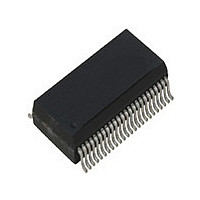ICS1893BF IDT, Integrated Device Technology Inc, ICS1893BF Datasheet - Page 55

ICS1893BF
Manufacturer Part Number
ICS1893BF
Description
PHYCEIVER LOW PWR 3.3V 48-SSOP
Manufacturer
IDT, Integrated Device Technology Inc
Series
PHYceiver™r
Type
PHY Transceiverr
Specifications of ICS1893BF
Protocol
MII
Voltage - Supply
3.14 V ~ 3.47 V
Mounting Type
Surface Mount
Package / Case
48-SSOP
Lead Free Status / RoHS Status
Contains lead / RoHS non-compliant
Number Of Drivers/receivers
-
Lead Free Status / Rohs Status
Not Compliant
Other names
1893BF
Available stocks
Company
Part Number
Manufacturer
Quantity
Price
Part Number:
ICS1893BF
Manufacturer:
ICS
Quantity:
20 000
Company:
Part Number:
ICS1893BFI
Manufacturer:
OKI
Quantity:
1 934
Part Number:
ICS1893BFILF
Manufacturer:
ICS
Quantity:
20 000
Company:
Part Number:
ICS1893BFLF
Manufacturer:
ICS
Quantity:
409
Part Number:
ICS1893BFLF
Manufacturer:
ICS
Quantity:
20 000
Part Number:
ICS1893BFLFT
Manufacturer:
IDT
Quantity:
20 000
7.2.5 Low Power Mode (bit 0.11)
7.2.6 Isolate (bit 0.10)
7.2.7 Restart Auto-Negotiation (bit 0.9)
ICS1893BF, Rev. F, 5/13/10
This bit provides one way to control the ICS1893BF low-power mode function. When bit 0.11 is logic:
•
•
Note:
This bit controls the ICS1893BF Isolate function. When bit 0.10 is logic:
•
•
The default value for bit 0.10 depends upon the PHY address of
•
•
This bit allows an STA to restart the auto-negotiation process in Software mode (that is, the HW/SW pin is
logic one). When bit 0.12 is logic:
•
•
Zero, there is no impact to ICS1893BF operations.
One, the ICS1893BF enters the low-power mode. In this case, the ICS1893BF disables all internal
functions and drives all MAC output pins low except for those that support the MII Serial Management
Port. In addition, the ICS1893BF internally activates the TPTRI function to tri-state the signals on the
Twisted-Pair Transmit pins (TP_TXP and TP_TXN) and achieve additional power savings.
Zero, there is no impact to ICS1893BF operations.
One, the ICS1893BF electrically isolates its data paths from the MAC Interface. The ICS1893BF places
all MAC output signals (TXCLK, RXCLK, RXDV, RXER, RXD[3:0], COL, and CRS) in a high-impedance
state and it isolates all MAC input signals (TXD[3:0], TXEN, and TXER). In this mode, the Serial
Management Interface continues to operate normally (that is, bit 0.10 does not affect the Management
Interface).
Is equal to 00000b, then the default value of bit 0.10 is logic one, and the ICS1893BF isolates itself from
the MAC Interface.
Is not equal to 00000b, then the default value of bit 0.10 is logic zero, and the ICS1893BF does not
isolate its MAC Interface.
Zero, the Auto-Negotiation sublayer is disabled, and the ICS1893BF isolates any attempt by the STA to
set bit 0.9 to logic one.
One (as set by an STA), the ICS1893BF restarts the auto-negotiation process. Once the auto-negotiation
process begins, the ICS1893BF automatically sets this bit to logic zero, thereby providing the
self-clearing feature.
ICS1893BF Data Sheet Rev. F - Release
There are two ways the ICS1893BF can enter low-power mode. When entering low-power mode:
•
•
By setting bit 0.11 to logic one, the ICS1893BF maintains the value of all Management Register
bits except the latching high (LH) and latching low (LL) status bits, which are re-initialized to their
default values instead. (For more information on latching high and latching low bits, see
7.1.4.1, “Latching High Bits”
During a reset, the ICS1893BF sets all management register bits to their default values.
and
Copyright © 2009, IDT, Inc.
Section 7.1.4.2, “Latching Low
All rights reserved.
55
Table
7-16. If the PHY address:
Chapter 7 Management Register Set
Bits”.)
May, 2010
Section
















